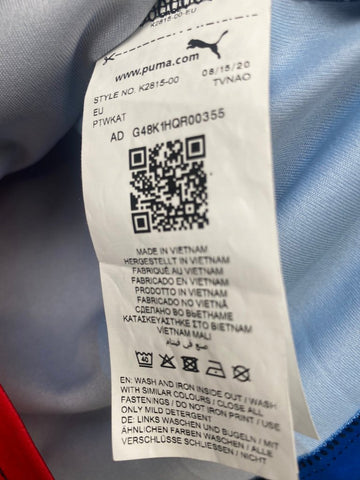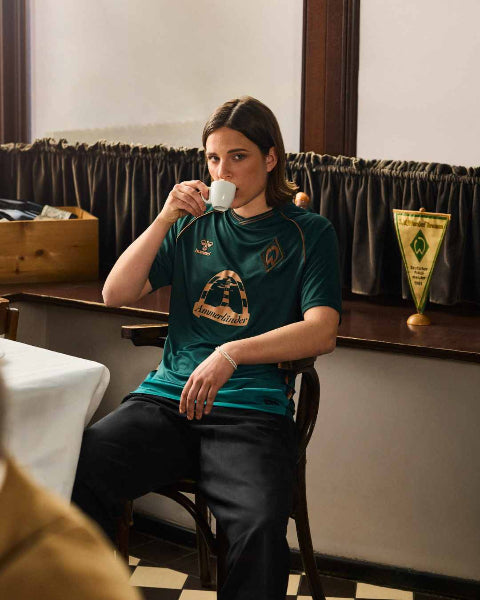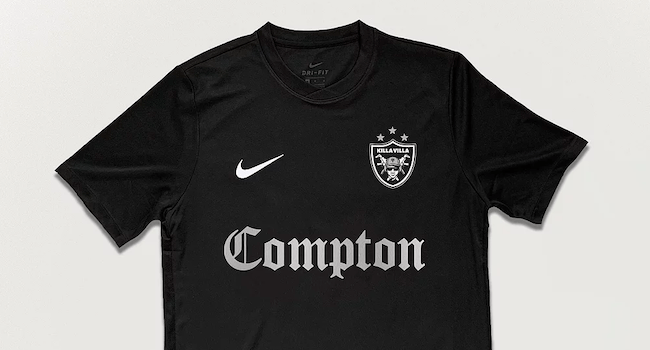Recently added
Vintage shirts
Concept kits
Legends
How to spot a fake Puma football shirt
by Phil Delves February 05, 2022 5 min read

Puma have consistently been one of the biggest players in world football. No matter which way you look at the football shirt scene, the big cat are the consensus number 3 in the pecking order behind Nike and adidas.
On their day, Puma have more than matched the big two, and despite some controversial away kits for their national teams this year (which aren't as bad you think, but that's another story...), a resurgent Italy are carrying the torch for the brand in a big way at the Euros.
How to spot fake football shirts by brand
| Nike | Kappa | adidas | General |
We’re not here to talk about the successes or failures of Puma sponsored teams however; we’re here to talk about spotting a fake Puma football shirt. Given their high profile, there are more than a few counterfeit Puma vintage football shirts floating about.
As we did with our previous features on Nike, adidas and Kappa, we’ll be focusing in on various areas of a shirt which can help you as you figure out if the pictures you’re looking at are of a genuine shirt or not.
And once again, thanks to the various members of the shirt community who helped out by providing pictures for this article!
Puma product code / internal labels
As has been a theme with all our fake guides so far, the product codes are your best chance of an assist when trying to ‘score’ a successful fake search.
The number you’re looking for can be found on the internal label of the shirt. Simply search “Puma” followed by the style no, and you should see results of the shirt the label is attached to.

Don’t be alarmed if no results of a shirt are found. For unknown reasons, a number of legitimate shirts I’ve looked at do no return any results on Google, like this label below which is on a genuine Crystal Palace shirt.

What would be alarming however is a product code that returns a range of different Puma shirts. For example, the label below is supposed to be for a Borussia Dortmund shirt, but a search for the code shows a number of shirts, most prominently a Uruguay shirt.

Puma logo
The Puma logo is distinctive for its sleek aesthetic. The sharp lines of the big cat silhouette are an area fakers often get wrong, and you want to pay special attention to the back legs of the Puma logo which are often approximated on dodgy kits.
In case you needed reminding, here is a real Puma logo for reference.

Below is a comparison between another real Puma logo (L), and the logo on a fake Puma football shirt (R). Key differences include less pronounced ears on the cat and a slightly chunkier figure all round, most notably on the back legs as mentioned earlier.

Vintage Puma
Shirt construction
Though shirt constructions for all manufacturers change as time goes on, I want to highlight a typical example which can be applied to other shirts from other eras.
Many of Puma’s shirts in 2019 featured a small, stretch panel on the back of the neck, broadly similar to Nike shirts from the late 10s in terms of aesthetic and function. On real shirts this panel is nice and tight with little if any sagging, whereas fakes of this shirt type (pictured below) will often fall short in this particular area.

As with any point on this list, be sure to compare with pictures of real shirts and ask for more pictures if unsure.
Jock tag
A word on the jock tag or authenticity tag area of the shirt. At the bottom left of a modern Puma shirt as you look at it front on, you’ll see a small black patch with a code written on it.
Unlike the codes on the internal labels of a Puma shirt, searching this by itself will not necessarily return results of a shirt, unless it’s a fake. In both the pictures below, you’ll notice a comparison between a real and fake shirt. Curiously, both pictures have shirts with an identical jock tag number despite the fact these are supposed to be two completely different shirts.


These codes should be unique, and as a general rule of thumb a small number is a warning sign. Though I can’t say for definite, all the pictures of genuine Puma shirts I’ve seen have had jock tag codes that start with a 1, whilst conversely fakes typically start with at least a few 0s.
Crest
Though not brand specific, I want to finish with a roundup of a key area for any football shirts in regards to fake spotting; the club crests. Due to their relatively intricate nature, crests are often badly reconstructed on fake shirts, and in most cases I often look to the crest before anything else.
We return to our Arsenal shirt comparison here, and I don’t need to tell you which is which.

We also have this Dortmund shirt, which has a lot of problems. The Dortmund crest is an obvious one, but you could also point to the shoddy Bundesliga patch (with a yellow silhouette I’ve not seen before?), sponsor size and placement, or the integrity of the pattern throughout the body of the shirt.

Bizarrely, the Puma logo actually looks reasonable on this fake, which just goes to show that you should check a variety of areas of a shirt before determining if it’s real or not.
Thanks once again to everyone who provided pictures for this piece. If you have any other tips for how to spot a fake Puma football shirt, feel free to leave a comment on this piece. Don’t forget to brush up on your knowledge for other manufacturers by reading out previous brand fake spotting guides, and for all other questions you might have about football shirt collecting, our Collectors Club series has covered a wide range of topics.
We’ll be covering more questions in the coming weeks, so stick with us.
Our most popular collections of authentic football shirts
| All vintage shirts | Arsenal | Manchester United | Liverpool |
If you enjoyed this blog on fake Puma shirts then why not sign-up to our weekly Collectors Club Newsletter to receive more great tips each week? You can sign-up here.
Phil Delves
As Head of Content, Phil is the creative playmaker of the team, covering every angle of football shirt news in our blogs and weekly Newsletter. Whether it's telling your fakes from your authentics, or deep dives into the newest football shirts designs, Phil will have all your football shirt content needs covered.
Sidebar
- Premier League football shirts
-
Other English clubs
- Birmingham City
- Blackburn Rovers
- Charlton Athletic
- Coventry City
- Derby County
- Hull City
- Ipswich Town
- Leicester City
- Middlesbrough
- Millwall
- Norwich City
- Portsmouth
- Preston North End
- Queens Park Rangers
- Sheffield United
- Sheffield Wednesday
- Southampton
- Stoke City
- Swansea City
- Watford
- West Bromwich Albion
- Scottish clubs
- Italian club shirts
- Spanish club shirts
- German club shirts
- International
- French club shirts
- Rest of the world
-
Legends
- Adriano
- Alessandro Del Piero
- Andrey Arshavin
- Alvaro Recoba
- Bobby Moore
- Bryan Robson
- Bukayo Saka
- Clarence Seedorf
- Cristian Vieri
- Cristiano Ronaldo
- David Beckham
- David James
- David Seaman
- David Ginola
- Dennis Wise
- Dennis Bergkamp
- Didier Drogba
- Dimitar Berbatov
- Diego Maradona
- Edgar Davids
- Eric Cantona
- Fernando Torres
- Freddie Ljungberg
- Gabriel Batistuta
- Gianluca Vialli
- Gianluigi Buffon
- Giovanni Elber
- Frank Lampard
- Francecso Totti
- Haaland
- Harry Kane
- Hidetoshi Nakata
- Ian Wright
- Jari Litmanen
- Ji Sung Park
- Juninho
- Jurgen Klinsmann
- Kaka
- Landon Donovan
- Lionel Messi
- Lothar Mattaus
- Luis Figo
- Mark Viduka
- Matt Le Tissier
- Mesut Özil
- Michael Owen
- Mikel Arteta
- Neymar
- Nicolas Anelka
- Nwankwo Kanu
- Paolo Di Canio
- Paolo Maldini
- Patrick Vieira
- Rafael Van der Vaart
- Raul
- Riquelme
- Rivaldo
- Robert Pires
- Roberto Baggio
- Robbie Fowler
- Ronaldo Nazario
- Ronaldinho
- Roy Keane
- Rudi Voller
- Ruud Gullit
- Ryan Giggs
- Santi Carzola
- Steve Bull
- Steven Gerrard
- Teddy Sheringham
- Thierry Henry
- Tony Adams
- Toto Schillaci
- Tugay
- Wayne Rooney
- Xabi Alonso
- Zinedine Zidane
- Zola
- Brands
Subscribe
Sign up to get the latest on sales, new releases and more …













